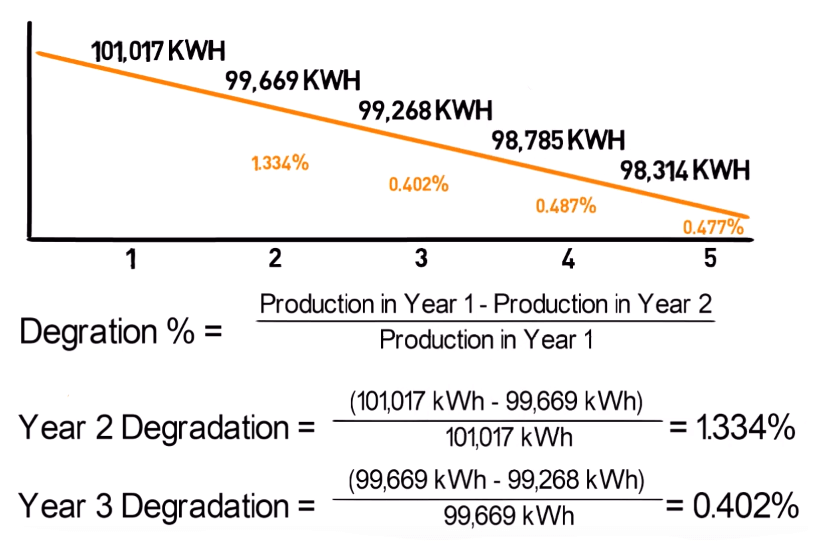In the realm of renewable energy, solar panels are a beacon of hope. They promise a future of energy independence, harnessing the power of the sun to provide a sustainable source of electricity. However, like all things, solar panels aren’t immune to the passage of time. They degrade, losing their efficiency bit by bit. But what does this degradation entail, and what factors contribute to it?
The Inevitability of Degradation
Degradation in solar panels refers to a gradual decrease in their power output or efficiency. This is a natural process, influenced by a variety of factors, both internal and external. It’s important to note that all solar panels degrade, but the rate and extent of degradation can vary. High-quality panels often maintain up to 90% production efficiency even after 20-25 years of operation. The degree of degradation of solar panels is usually taken into account in the quality assurance of products from their manufacturers.
The Rate of Degradation
During the first year of operation, solar panels typically experience short-term degradation ranging from less than 1% to 3%. After that, according to several studies, their productivity decreases by an average of 0.8% to 0.9% annually.
Types of Solar Panel Degradation
Solar panel degradation can be categorized into three types:
- Light Induced Degradation (LID): This occurs when a solar panel is first exposed to solar radiation, resulting in a decrease in its photoconductivity. This is considered the panel’s “setup” stage, also referred to as “initial degradation” or short-term degradation, and occurs within the first 1000 hours of operation. The effectiveness of the panels at this stage decreases by an average of 1-3% and after that it stabilizes. This type of degradation is inherent mainly in single-crystal panels.
- Potential Induced Degradation (PID): This type of degradation doesn’t always occur, but when it does, the performance of the panel can be reduced by up to 30%. All types of panels are subject to it (mono- and polycrystalline, as well as thin-film). In some cases, potential degradation can be reversible, but this process is always a rather difficult technical problem that requires an immediate solution.
- Aging-related Degradation: This type of degradation occurs due to chemical reactions in semiconductors that cause crystalline hardening, as well as due to contamination of photomodules, climatic conditions, weather, and ultraviolet radiation. Usually this type of degradation is irreversible, and from an economic point of view there is no point in eliminating it.
Factors Accelerating Degradation
Several factors can accelerate the rate of degradation:
- Quality of Materials: To keep prices low, some manufacturers use thinner aluminum for the frame, making the frame thinner and more vulnerable to degradation. This is why choosing a cheap solar panel can increase the risk of poor performance or failure of system parts. In the long run, these savings will cost you more.
- Type of Panel: The degree of degradation of the solar panel and its service life depend on the type of panel. For example, crystalline panels are more resistant to normal wear and tear than thin film panels, as reflected in their warranties and lifetimes. For example, under normal conditions, crystalline panels can withstand extreme temperatures and cold for more than 20 years. Film panels under the same conditions will last no more than 5 years.
- Extreme Climatic Conditions: When exposed to extreme climatic conditions, a crystalline silicon (Si) solar panel can be severely degraded. For example, a panel exposed toheavy snow loads, winds, and heat loses its structural integrity and efficiency. Whereas the rate of degradation of panels installed in a favorable climate will be significantly lower.
- Connection Problems: Problems when connecting with other elements can also lead to degradation. Usually, solar panels are not fragile and are practically not subject to any breakage. But when connecting them with other elements of the solar installation or combining them into arrays, care must be taken. It is necessary to take into account not only the safety of solar panels but also the entire connected system, correctly connect its elements in accordance with their technical parameters.
- Mechanical Damage: Although manufacturers use tempered glass for added protection, constant stress can cause micro-cracks in solar cells, which can accelerate the degradation process. The anti-reflective/anti-reflective coating may also deteriorate. These destructions are caused by heating of the surface of the panels, exposure to ultraviolet radiation, and pollutants.
- Pollution: The most common factor affecting the life and rate of degradation of panels is pollution. Tiny particles of dust and dirt gradually accumulate on the surface of the solar cell, thereby reducing the amount of sunlight received by the solar cells. Studies have shown that a solar panel can lose about 1% of its efficiency because of this. Moreover, these panels are more likely to lose their power due to contamination when placed on a flat surface. While solar panels are fairly easy to install on flat roofs, this results in more dust accumulating on the panels and therefore degrading more quickly.
- Weather Disasters: Strong squalls, hurricanes, storms, snow, large hail, fallen tree branches due to wind – all these factors can significantly damage solar panels and accelerate their degradation. This must be taken into account when installing panels, for example, choose places at a considerable distance from trees.
- Birds: The structural integrity of the solar panel is also threatened by birds that like to build nests under the panels.
When deciding to buy solar panels, be sure to take into account the degree of their degradation, since in the end this indicator can affect the payback period of the installation. Knowing the main causes of degradation, you can smooth out some points and try to slow it down in those cases in which this is possible. We will talk about what needs to be done for this in the following publications.
